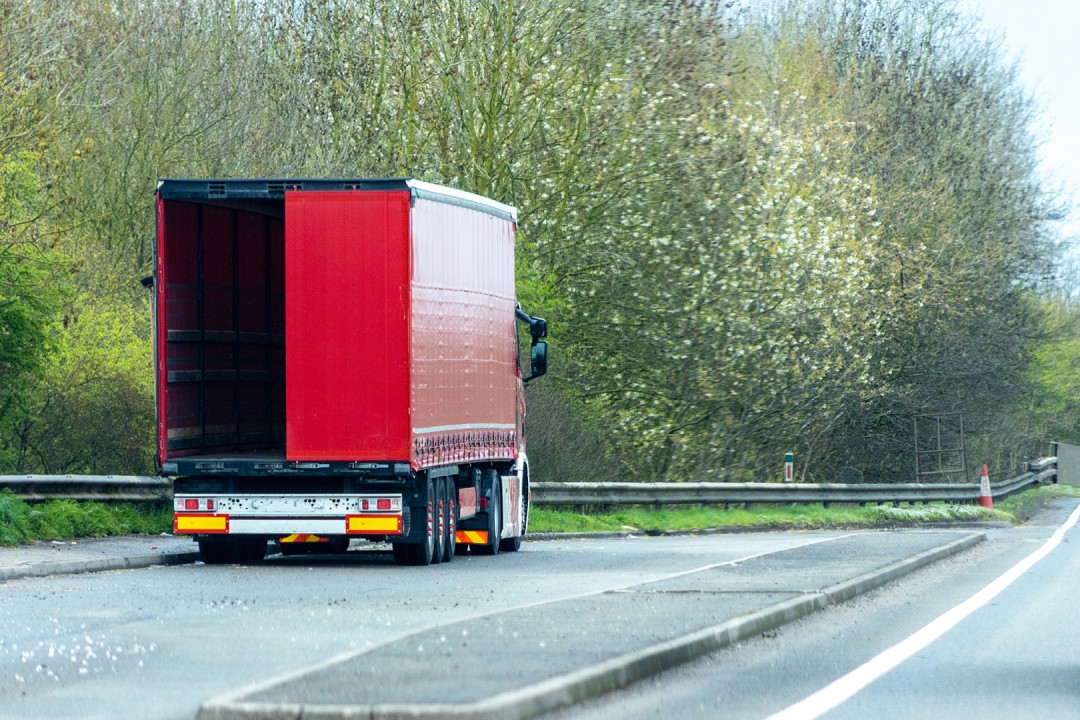
Susie Jones
Uprednostňujú vodiči odpočívadlá pred čerpacími stanicami
Vytvorené: 19. 08. 2024
•
Aktualizované: 19. 08. 2024
V roku 2022 bolo v Spojenom kráľovstve zaznamenaných viac ako 5 000 hlásení trestných činov v nákladnej doprave, čo predstavuje stratu približne 66 miliónov libier. Zvýšená kriminalita v nákladnej doprave predstavuje kritickú hrozbu pre dodávateľské reťazce, podniky a spotrebiteľov - čo spôsobuje značné obavy pre subjekty pôsobiace v odvetví nákladnej dopravy.
Podľa správy, ktorú zverejnila polícia v grófstve Cambridgeshire, sa 46 % všetkých krádeží nákladu stalo na uliciach a odpočívadlách a 27 % na čerpacích staniciach. Napriek tomu sociálny prieskum ukazuje, že mnohí vodiči naďalej z rôznych dôvodov parkujú na odstavných plochách.
Problémy s odstavnými parkoviskami
Parkovanie cez noc na odstavnom parkovisku je pre vodičov často najjednoduchšou a najekonomickejšou možnosťou. Predstavuje však niekoľko nevýhod, ktoré môžu mať negatívny vplyv na duševné zdravie a bezpečnosť vodiča.
Zariadenia - Vodiči potrebujú viac zariadení, ako sú toalety, sprchy a jedlo. Nedostatok čistých zariadení môže zvýšiť nepohodlie a negatívne ovplyvniť spánok, koncentráciu a duševné zdravie.
Bezpečnosť vodičov - Odkladacie parkovanie predstavuje dodatočné riziko pre bezpečnosť vodičov. Štúdia AA zistila, že dve tretiny smrteľných nehôd s účasťou stojacich vozidiel na dvojprúdovej ceste sa stali na odstavných plochách - viac ako polovica zrazených vozidiel boli ťažké nákladné vozidlá.
Krádeže nákladu - v odvetví došlo v období jún-júl 2023 k nárastu krádeží nákladu o 380 %, čo poukazuje na potrebu bezpečného a chráneného parkovania. Keďže oportunistickí zlodeji sa zameriavajú na odstavné plochy, vodiči riskujú, že prídu o svoj náklad, a vozové parky riskujú stratu miliónov libier.
Prečo vodiči parkujú na odstavných plochách
Napriek rizikám sociálny prieskum uskutočnený prostredníctvom Facebooku naznačil, že 70 % vodičov je menej ochotných vybrať si parkovisko pre nákladné vozidlá namiesto odstavnej plochy z niekoľkých dôvodov:
Bezpečnosť
Zo spätnej väzby zo sociálnych médií vyplýva, že 43 % vodičov nákladných vozidiel sa rozhodlo neparkovať na zastávke alebo čerpacej stanici pre nákladné vozidlá z dôvodu nedostatočných bezpečnostných opatrení.
"Parkujem len na odstavných plochách alebo v priemyselných zónach. Keď som zaparkoval v servisoch alebo na zastávkach pre nákladné autá, tak som mal prestrihnuté záclony," tvrdí vodič kamiónu Luke.
Bezpečnosť a ochrana zastávok nákladných vozidiel v Spojenom kráľovstve je v odvetví nákladnej dopravy horúcou témou diskusií - vodiči žiadajú vládu o väčšiu podporu pri zabezpečovaní dodatočných bezpečnostných zariadení. Na základe predchádzajúcej spätnej väzby si vodiči želali, aby sa poplatok za nákladné vozidlá investoval do bezpečnejších, hygienickejších a cenovo dostupných parkovísk.
V sociálnych médiách 59 % vodičov nákladných vozidiel uviedlo, že v Spojenom kráľovstve nie je v porovnaní s Európou dostatok bezpečných zastávok pre nákladné vozidlá. Tento názor podporuje aj spätná väzba z SNAP's Truck Park Tour, kde 31 % európskych vodičov uviedlo, že najviac profitujú z prístupu k exkluzívnym, bezpečným miestam SNAP. Bezpečnostná organizácia TAPA je v Európe všeobecne uznávaná - mnohé miesta majú certifikáty úrovne 1, 2 alebo 3.
Naproti tomu v Spojenom kráľovstve sú len dve pracoviská s certifikátom TAPA, pričom tieto pracoviská akreditujú autorizovaní audítori SNAP PSR 3. úrovne. Formula Services a The Red Lion majú certifikát 3. úrovne - v The Red Lion bol nahlásený jeden priestupok a v Formula Services žiadny, napriek tomu, že sa nachádza v oblasti s vysokou kriminalitou.
Markus Prinz, senior manažér pre normy, školenia a certifikáciu v TAPA, vysvetľuje: "Plne podporujeme všetky aktivity na zabezpečenie efektívnej a bezpečnej parkovacej infraštruktúry pre nákladné vozidlá a zvýšenie bezpečnosti vodičov nákladných vozidiel, vozidiel a nákladu. Veríme, že poskytnutím otvoreného ekosystému pre technickú a ekonomickú optimalizáciu bezpečného parkovania nákladných vozidiel možno podporiť prechod na bezpečné parkovanie nákladných vozidiel."
Neochota spoločnosti
30 % vodičov uviedlo, že ich flotilové spoločnosti nie sú ochotné platiť za zastávky pre nákladné vozidlá alebo čerpacie stanice. Jeden z vodičov vysvetlil:
"Menej firiem, žiaľ, platí za nočné parkovanie, zariadenia zostávajú otvorené len vďaka tomu, že znižujú počet zamestnancov, aby splnili účty, a menej parkovacích miest prichádza."
Zastávky nákladných vozidiel s maximálnou kapacitou
"Ktoré zastávky sú zabezpečené, sa dá zistiť podľa toho, že do 18.00 sú plné."
70 % vodičov vyjadrilo svoju nespokojnosť s tým, že zabezpečené zastávky pre kamióny sú maximálne vyťažené, takže im nezostáva nič iné, ako zaparkovať na odstavnej ploche. Podobný názor vyjadrili aj účastníci prehliadky parkovísk pre kamióny - mnohí vyjadrili svoje obavy z toho, že miesta v Spojenom kráľovstve sú plné ešte pred príchodom.
V údajoch z prieskumu TfL 2022 o parkovaní nákladných vozidiel sa uvádza, že napriek 12 % nárastu kapacity na mieste v rokoch 2017 - 2022 to nestačí na pokrytie 21 % nárastu vozidiel v rovnakom období.

Obmedzenie nočného parkovania na odstavných plochách
Vládne financovanie
18 % vodičov si želá, aby vláda poskytla viac finančných prostriedkov na podporu bezpečnostných zariadení. V septembri 2023 ministerstvo dopravy pridelilo 8 miliónov libier 39 cestným zariadeniam v Anglicku na zlepšenie zariadení a bezpečnosti. Tím SNAP pre prístup a bezpečnosť začína podporovať spoločnosti, ktoré získali finančné prostriedky, realizáciou ich zlepšení. Ďalšie finančné prostriedky až do výšky 100 miliónov GBP sú k dispozícii do roku 2025 v rámci vládneho programu spolufinancovania.
Bezpečnostné inštalácie
Na zabezpečenie bezpečného priestoru pre vodičov nákladných vozidiel môžu zastávky investovať do robustných bezpečnostných zariadení - produkty ako CCTV, ANPR, interkom, zábrany a kiosky posilňujú bezpečnosť na mieste a zabraňujú trestnej činnosti. Spoločnosť SNAP Access & Security spája na mieru šité bezpečnostné produkty a odborné znalosti trhu s cieľom chrániť osoby, vozidlá a obsah na zastávkach pre nákladné vozidlá.
Môžu vodiči nákladných vozidiel spať na okraji cesty v Spojenom kráľovstve?
Od 1. novembra 2017 zaviedol DVSA nové pravidlá a predpisy týkajúce sa odpočinku vodičov na miestach, ako sú obytné oblasti a odpočívadlá. Vodiči môžu dostať pokutu až do výšky 300 libier, ak strávia prestávku na odpočívadle alebo na okraji cesty.
Ako zostávajú vodiči nákladných vozidiel počas jazdy v bdelom stave?
Vodiči nákladných vozidiel musia v záujme svojej bezpečnosti a bezpečnosti všetkých ostatných účastníkov cestnej premávky dodržiavať pravidlá tachografu. Účelom tachografu je zabrániť únave vodičov a zabezpečiť, aby vodiči a zamestnávatelia dodržiavali pravidlá.
Napriek tomu je predchádzanie nude a únave na cestách pre mnohých vodičov náročné a môže ovplyvniť ich pohodu. Väčšina vodičov uprednostňuje počas cesty počúvanie hudby a podcastov a vyžíva sa v sociálnej interakcii s ostatnými vodičmi na zastávkach kamiónov a čerpacích staniciach.
Môžu mať vodiči nákladných vozidiel v Spojenom kráľovstve cestujúcich?
Priemerný vodič nákladného vozidla strávi za volantom približne 12 hodín denne. V rámci boja proti osamelosti a nude môžu vodiči prepravovať cestujúcich, ak dodržiavajú osobitné predpisy stanovené FMSCA. Vodiči musia získať písomné povolenie od svojej spoločnosti predložením žiadosti o prepravu cestujúcich - v tejto žiadosti musí byť uvedené trvanie cesty a dátumy.
Spoločné požiadavky sú tieto: - Cestujúce nesmú byť tehotné.
Nesmú trpieť závažnými alebo chronickými zdravotnými ťažkosťami.
Musia byť staršie ako desať rokov
Zdravotné poistenie je povinné.



